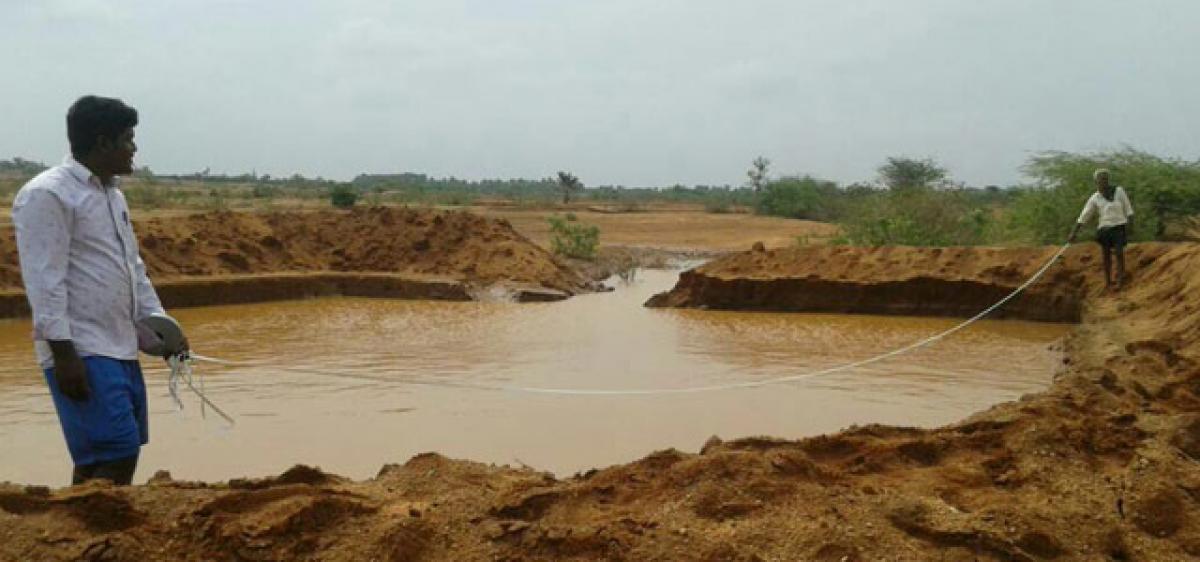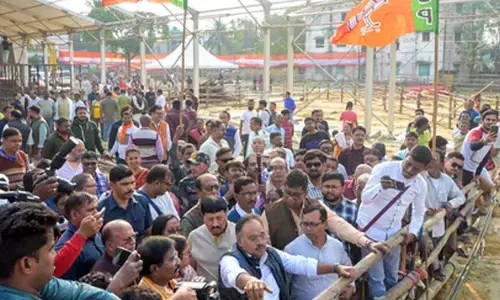Rain God smiles, Kuderu ponds filled to the brim

As rains lashed parts of the district on Tuesday night accompanied by thunder and lightning, farmer Obulakonda of Aravakuru panchayat village was excited to see his farm pond teeming with the elixir of life, even as he woke up from sleep on Wednesday morning. A farm pond full of rainwater was beyond his imagination.
Kuderu (Anantapur): As rains lashed parts of the district on Tuesday night accompanied by thunder and lightning, farmer Obulakonda of Aravakuru panchayat village was excited to see his farm pond teeming with the elixir of life, even as he woke up from sleep on Wednesday morning. A farm pond full of rainwater was beyond his imagination.
He had dug farm pond in his 5 acre agriculture land, under pressure put on him by District Water Management Agency (DWAMA) personnel but a farm pond filled with rainwater to its brim has totally changed his perception of the water conservation campaign -- ‘Neeru-Pragathi’.
HIGHLIGHTS:
- Each farm pond has a capacity to hold 3 lakh litres
- The 6,000-odd farm ponds conserved 180 crore litres of rainwater
- The ponds improved groundwater table of the region which has 3,000 borewells
"In the past, I thought digging a farm pond is a waste of farm land as it occupied a lot of space. I used to wondered what is the use of having large tracts of agriculture land without water," said Obulu, as he is fondly called in the village.
The district experienced rains in Kuderu mandal, Aravakuru panchayat, Bommanahal, Somandepalle and Hindupur mandals. The rains filled 6,046 farm ponds in these mandals. Each farm pond has a capacity to hold 3 lakh litres. The 6,000-odd farm ponds have conserved 180 crore litres of rainwater.
These farm ponds have not only boosted groundwater tables of the region but also could have recharged 3,000 borewells. as scientifically one farm pond with water can recharge two borewells.
The rainfall registered for two days include 58.6 centimetres in Mudigubba, 26.8 cm in Amarapu, 24.7 cm in Kalyandurg, 19.1 cm Agali, 19 cm Bramhasamudram, 16.7 cm Roddam, 16.2 cm Settur and 15 cm in Vidapanakal.
“With nearly 60,000 farm ponds completed and another 28,644 farm ponds set to be completed by July out of the target of one lakh ponds, one can imagine the water revolution the farm ponds can usher in,” says DWAMA project director A Nagabhushanam during a chat with The Hans India.
Singanamala and Dharmavaram mandals have 800 ponds each, the highest number of farm ponds dug in the respective mandals. For digging one farm pond 330 NREGS (National Rural Employment Guarantee Scheme) workers are engaged for over two weeks.
Venkatalakshmi, a woman who worked along with other NREGS workers to dig a farm pond in Bommanahal mandal in her own agriculture land is all the more excited. Her joy knew no bounds when rains lashed her village and filled the pond in her land overnight.
“Just until the other day everything seemed hopeless but now I can confidently irrigate my drying horticulture crops and save my plantation in two acres of land," a beaming Venkatalakshmi said.
These are unexpected rains and have come at a time when actually weathermen are talking about monsoon hitting Kerala by May 30. A couple of uniform heavy rains if registered in the district can fill all the 50,000-odd farm ponds that are ready to take rainwater.
Speaking to The Hans India, District Collector Veera Pandian said that Chief Minister N Chandrababu Naidu’s pet project Neeru Pragathi is aimed at intensifying the water conservation campaign state-wide for 90 days, as part of his vision for the district to conserve every drop of water and also for shooting up the groundwater table in the district.
The Neeru Pragathi programme would create permanent water conservation assets to hold every drop of water.DWAMA and Andhra Pradesh Micro Irrigation Programme (APMIP) have been given crucial responsibilities in the execution of the initiatives within 90 days.
The other departments that have been involved through convergence include forest department, horticulture department, irrigation department and even education department. The total cost of the project is Rs 408.7 crore. An amount of Rs 229 crore had been pooled through convergence while the remaining Rs 179.5 crore would be released by the government as the works progress.
DWAMA will spend a lion’s share of Rs 225 crore for farm ponds, check dams while APMIP would spend Rs 150 crore and micro irrigation department Rs 14 crore, irrigation department Rs 10 crore, horticulture Rs 5 crore, forest department Rs 4.5 crore and education department Rs 20 lakh on water conservation schemes.
The HNSS (Handri-Neeva Sujala Sravanti) project, through which Krishna water would come, will also fill water bodies in the district. Creation of water conservation assets will go a long way in ushering in a water revolution.














